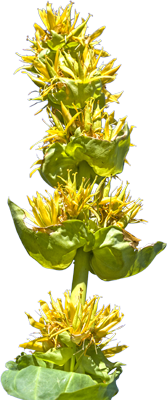חלק הצמח | איכויות | רכיבים פעילים | התוויות | מינונים | רגישות | תופעות לוואי |
מינון יתר | אזהרות | התוויות נגד | רעילות | אינטראקציות | הריון | הנקה
שם הסוג Gentiana נגזר משמו של Gentius, מלך איליריה העתיקה, שהיה הראשון לגלות את סגולותיו הרפואיות של הצמח.
שם המין נגזר מהמילה הלטינית lúteus, שפירושה צהוב, ומתייחס לצבע הפריחה של הצמח.
ג'נטיאן הינו צמח רב שנתי עשבוני. מוצאו באיזורים הרריים במרכז ובדרום אירופה.
ג'נטיאן מותר לשיווק בישראל.

חלק הצמח בשימוש
שורש.
איכויות
טמפרטורה: קר.
לחות: יבש.
טעם: מר.
רכיבים פעילים עיקריים
סקו-אירידואידים (gentiopicroside (1%-4%), amarogentin, swertiamarine, sweroside), קסנתונים (gentisin, gentisein, isogentisin, gentioside), אלקלואידים (gentianine), פנולים (gentisic acid, caffeic acid, protocatechuic acid), טריטרפנים (lupeol, b-amyrin), סטרולים, טאנינים, פוליסכרידים (inulin, pectin), אוליגוסכרידים (gentianose, gentiobiose), שמן נדיף.
התוויות
אנורקסיה, חוסר תיאבון, דיספפסיה.
מינונים
תמצית נוזלית בריכוז 1:3, 30% אלכוהול – 2-8 מ"ל ביום.
תמצית יבשה – תלוי בריכוז התמצית; מינון שווה ערך ל-600-2500 מ"ג צמח ביום.
מרתח – 2-6 גרם ביום.
בפורמולה – 15%-25%.
רגישות
לא ידועה רגישות מיוחדת.
תופעות לוואי
לעתים נדירות שימוש בג'נטיאן עלול לגרום למידע השלם למנויים
מינון יתר
מינון יתר עלול לגרום ל למידע השלם למנויים
אזהרות וצעדי מנע
מוטב להימנע משימוש בג'נטיאן במצבים של למידע השלם למנויים
התוויות נגד
אין להשתמש בג'נטיאן בקרב אנשים הסובלים מ למידע השלם למנויים
רעילות
לא נצפתה רעילות משמעותית למידע השלם למנויים
תגובות הדדיות עם תרופות / צמחי מרפא / תוספי תזונה
תרופות נוגדות דיכאון (מעכבי MAO) - למידע השלם למנויים
תרופות נוגדות-פטריות (Ketoconazole) - למידע השלם למנויים
הריון
קיימים חילוקי דעות בנושא. למידע השלם למנויים
הנקה
קיימים חילוקי דעות בנושא. למידע השלם למנויים
מקורות
- Mills. S, Bone K, The Essential Guide to Herbal Safety. Churchill Livingstone, 2005
- Blumenthal M, et al (eds): The complete German Commission E monographs: therapeutic guide to herbal medicines. Austin, 1998, American Botanical Council, p 135.
- Radix Gentianae Luteae. WHO Monographs on Selected Medicinal Plants. 3 vol. Geneva: World Health Organization; 2007:150-159.
- Hänsel R et al., eds. Hagers Handbuch der pharmazeutischen Praxis. Bd 5, Drogen E–O, 5th ed. [Hager’s handbook of pharmaceutical practice. Vol. 5, Drugs E–O, 5th ed.] Berlin, Springer, 1993.
- Weiss RF. Lehrbuch der Phytotherapie. 7th ed. [Textbook of phytotherapy, 7th ed.] Stuttgart, Hippokrates, 1991.
- Ozturk N, Husnu Can Baser K, Ozturk Y, et al: Phytother Res 16:627-631, 2002.
- Sherman JA (comp.). The Complete Botanical Prescriber, 2nd ed. National College of Naturopathic Medicine, Portland, Ore., 1979
- Harper-Shove F. Prescriber and Clinical Repertory of Medicinal Herbs. Health Science Press, Rustington, Sussex, Eng., 1952
- McGuffin M, Hobbs C, Upton R, Goldberg A (ed.). Botanical Safety Handbook. CRC Press, Boca Raton, 1997
- Brinker F. Herb Contraindications and Drug Interactions, 4th ed. Sandy (OR): Eclectic Medical Publications; 2010
- Brinker F. The Toxicology of Botanical Medicines, 3rd ed. Eclectic Medical Pub., Sandy, Ore., 2000
- Felter HW, Lloyd JU. King’s American Dispensatory [1898]. Eclectic Medical Pub., Sandy, Ore., 1993
- Wichtl M (ed.). Herbal Drugs and Phytopharmaceuticals. CRC Press, Boca Raton, 1994
- De Smet PAGM et al. (eds.). Adverse Effects of Herb Drugs 2. Springer-Verlag, Berlin, 1993
- Mills S, Bone K. Principles and Practice of Phytotherapy. Churchill Livingstone, Edinburg, 2000
- Wolf S, Mack M. Experimental study of the action of bitters on the stomach of a fistulous human subject. Drug Standards, 24(3):98-101, 1956
- Leslie GB. A pharmacometric evaluation of nine Bio-Strath herbal remedies. Medita, 1978, 8:31–47.
- Chibanguza G, Marz R. Sterner W: Arzneim Forsch 34:32-36, 1984.p
- Citova, I., Ganzera, M., Stuppner, H., and Solich, P. Determination of gentisin, isogentisin, and amarogentin in Gentiana lutea L. by capillary electrophoresis. J Sep.Sci 2008;31(1):195-200.
- Haraguchi, H., Tanaka, Y., Kabbash, A., Fujioka, T., Ishizu, T., and Yagi, A. Monoamine oxidase inhibitors from Gentiana lutea. Phytochemistry 2004;65(15):2255-2260.
- Amin, A. Ketoconazole-induced testicular damage in rats reduced by Gentiana extract. Exp Toxicol Pathol. 2008;59(6):377-384
- Radix Gentianae Luteae. WHO Monographs on Selected Medicinal Plants. 3 vol. Geneva: World Health Organization; 2007:150-159.
- Farnsworth NR, ed. NAPRALERT database. Chicago, IL, University of Illinois at Chicago, 9 February 2001 production (an online database available directly through the University of Illinois at Chicago or through the Scien- tific and Technical Network (STN) of Chemical Abstracts Services).
- Morimoto I et al. Mutagenic activities of gentisin and isogenisitin from Gentianae radix (Gentianaceae). Mutation Research, 1983, 116: 103–117.
- Matsushima T et al. Mutagenicities of xanthone derivatives in Salmonella typhimurium TA100, TA98, TA97, and TA2637. Mutation Research, 1985, 150:141–146.
- Göggelmann W, Schimmer O. Mutagenic activity of phytotherapeutical drugs. In: Knudsen I, ed. Genetic toxicology of the diet. New York, Alan R. Liss, 1986: 63–72.

דוגמא למונוגרף מלא
לרכישת מנוי |
כניסת מנויים
